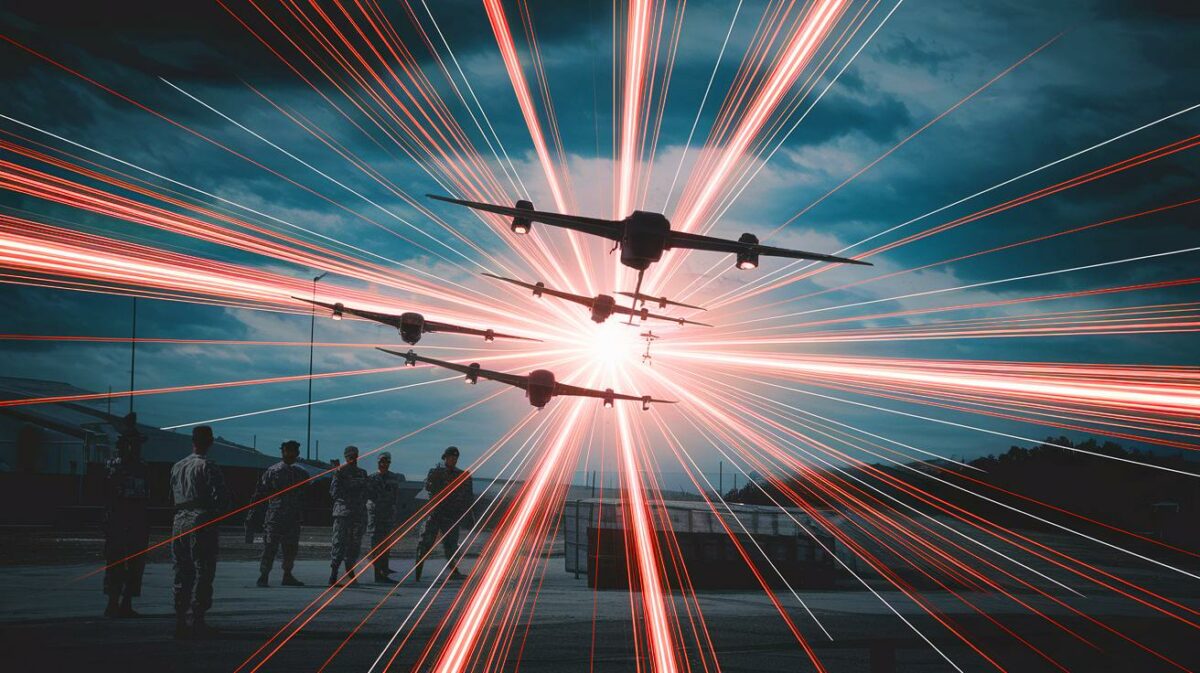| IN A NUTSHELL |
|
The British Army has made waves with its groundbreaking trial of an invisible radio wave weapon, known as the Radiofrequency Directed Energy Weapon (RFDEW). This revolutionary technology has successfully knocked out drone swarms, marking a significant milestone in modern warfare. Held in West Wales, this trial was the largest counter-drone exercise ever conducted by the British Army. As the use of drone swarms in combat zones continues to rise, this trial underscores the need for advanced defense systems capable of countering such threats. What does this mean for the future of military defense strategies?
The Revolutionary RFDEW: Cost-Effective and Powerful
The Radiofrequency Directed Energy Weapon (RFDEW) represents a monumental shift in military defense technology. According to the British Army, this demonstrator system is capable of neutralizing multiple targets simultaneously, showcasing its potential as a formidable asset in modern warfare. The UK government has already invested over $50 million in research and development for this technology, emphasizing its strategic importance.
One of the most astounding features of the RFDEW is its cost-effectiveness. With an operational cost of just 13 cents per shot, the weapon offers a budget-friendly alternative to traditional missile-based systems. This makes it an attractive option for military budgets, potentially saving millions while maintaining robust defense capabilities. The RFDEW can effectively neutralize airborne threats at ranges of up to 0.6 miles, offering a solution against threats impervious to electronic jamming.
In light of recent conflicts, such as those in Ukraine, where drone swarms have been increasingly deployed, the development of such technologies is crucial. The UK Ministry of Defence highlights the necessity of these trials, noting that Ukraine faced over 18,000 drone attacks last year alone.
Frying 100 Drones: A Showcase of British Innovation
In a remarkable display of capability, the British Army’s RFDEW system successfully engaged and defeated over 100 drones during its trials. This impressive feat was accomplished through the collaboration of Team Hersa, which includes Defence Equipment & Support and the Defence Science and Technology Laboratory, and was led by Thales UK.
The weapon’s development is a testament to the UK’s Defence Industrial Strategy, which aims to bolster the country’s defense industry while addressing global threats. By working with industry partners, the Ministry of Defence is committed to delivering powerful RFDEW capabilities to UK forces. This weapon is versatile, capable of targeting airborne threats from land, air, and sea, and can be mounted on platforms like the MAN Support Vehicle 6T.
Designed to operate independently or alongside short-range air defense systems, the RFDEW is poised to become an integral part of the UK’s defense arsenal. Maria Eagle, the UK’s Minister for Defence Procurement and Industry, emphasized the importance of this innovation, highlighting its role in strengthening the UK’s defense sector.
Implications for Global Defense Strategies
The successful trial of the RFDEW underscores a shift in global defense strategies, where traditional methods of air defense are supplemented by cutting-edge technologies. As drone swarms become more prevalent in combat scenarios, the need for innovative countermeasures becomes increasingly urgent. The RFDEW’s ability to neutralize threats quickly and effectively offers a glimpse into the future of military engagements.
This development also highlights the importance of international collaboration in defense innovation. By leveraging the expertise of industry leaders and scientific talent, the UK is setting a precedent for other nations to follow. The integration of directed energy weapons into existing defense frameworks could redefine how military forces worldwide approach aerial threats.
Furthermore, the economic advantages of the RFDEW cannot be overstated. As defense budgets face constraints, cost-effective solutions like the RFDEW provide a sustainable path forward. This technology not only enhances national security but also contributes to economic growth by fostering innovation in the defense sector.
Future Prospects and Challenges
As the RFDEW continues to evolve, its future prospects appear promising. The technology is expected to play a pivotal role in modern warfare, offering a versatile and efficient solution to emerging threats. However, several challenges remain, such as ensuring the scalability of the system and addressing potential vulnerabilities.
Ongoing research and development will be crucial to overcoming these challenges. By refining the technology and expanding its capabilities, the UK aims to maintain its position at the forefront of defense innovation. The RFDEW’s adaptability will be key to its success, as it must evolve alongside the changing landscape of military threats.
As countries around the world witness the potential of directed energy weapons, will this spark a new era of technological advancement in defense strategies? The RFDEW trial not only marks a triumph for British innovation but also raises important questions about the future of warfare and the role of technology in safeguarding national security.
Did you like it? 4.6/5 (28)









Wow, 13 cents per shot? That’s cheaper than my morning coffee! ☕